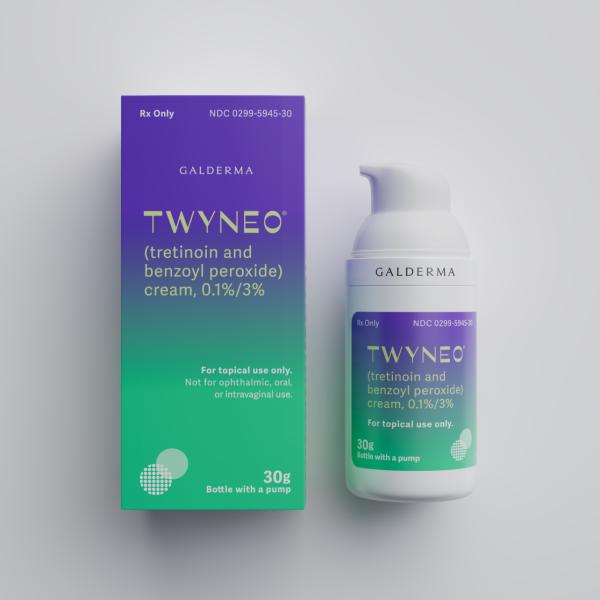Twyneo
Generic name: benzoyl peroxide and tretinoin
Dosage form: topical cream
Drug class: Topical acne agents
What is Twyneo?
Twyneo is a prescription medicine used on the skin (topical) to treat acne vulgaris in adults and children 9 years of age and older.
Important: Twyneo is for use on the skin only (topical). Do not use Twyneo in your mouth, eyes, or vagina.
It is not known if this medicine is safe and effective in children below 9 years of age.
Who should not use Twyneo?
You should not use Twyneo if you have had an allergic reaction to benzoyl peroxide or any of the ingredients. See the end of this page for a complete list of ingredients.
Before using Twyneo
Before you start treatment, tell your healthcare provider about all of your medical conditions, including if you:
- have other skin problems, including eczema, cuts, or sunburn
- have skin sensitivity to the sun
- are pregnant or plan to become pregnant. It is not known if Twyneo will harm your unborn baby.
- are breastfeeding or plan to breastfeed. It is not known if Twyneo passes into your breast milk. Talk to your healthcare provider about the best way to feed your baby during treatment.
Tell your healthcare provider about all the medicines you take, including prescription and over-the-counter medicines, vitamins, and herbal supplements.
How should I use Twyneo?
- Use Twyneo cream exactly as your healthcare provider tells you to use it.
- Apply the cream to the affected areas 1 time a day.
- Apply the cream on clean and dry skin.
- Twyneo comes in a bottle with a pump. Press down on (depress) the pump to dispense a small amount of the cream on your fingertip. Apply a thin layer of the cream to the affected skin areas. Avoid contact with your eyes, lips, corners of your nose, and mouth.
- Wash your hands right away after applying Twyneo.
What should I avoid while using Twyneo?
- Avoid using Twyneo on skin areas with cuts, abrasions, eczema, or sunburns.
- Limit your time in sunlight. You should avoid using sunlamps, tanning beds, and ultraviolet light during treatment. If you have to be in the sunlight or are sensitive to sunlight, use sunscreen and wear protective clothing or a wide-brimmed hat to cover the treated areas.
- Avoid getting Twyneo in your hair or on colored fabric. Twyneo may bleach hair or colored fabric.
Twyneo side effects
Twyneo may cause serious side effects including:
- Allergic reactions. Stop treatment and get medical help right away if you have any of the following symptoms:
- hives, rash or severe itching
- swelling of your face, eyes, lips, tongue, or throat
- trouble breathing or throat tightness
- feeling faint, dizzy, or lightheaded
- Skin irritation. Twyneo may cause skin irritation such as redness, scaling, peeling, dryness, pain, stinging or burning. If you develop these symptoms, your healthcare provider may tell you to use a moisturizer, decrease the number of times you apply Twyneo, or completely stop treatment.
The most common side effects include pain, dryness, peeling, redness, swelling, itching, and irritation at the application site.
These are not all the possible side effects. Call your doctor for medical advice about side effects. You may report side effects to FDA at 1-800-FDA1088. You may also report side effects to Sol-Gel Technologies, Inc. at 1-866-748-2377.
Related/similar drugs
What other drugs will affect Twyneo?
Many drugs can interact with benzoyl peroxide and tretinoin, and some drugs should not be used at the same time. Tell your doctor about all other medicines you use. This includes prescription and over-the-counter medicines, vitamins, and herbal products. Not all possible interactions are listed here.
How should I store Twyneo?
- Store Twyneo at room temperature between 68°F to 77°F (20°C to 25°C).
- Throw away (discard) Twyneo 12 weeks after the date you receive it or 30 days after first opening, whichever is sooner.
- Do not freeze.
Keep all medicines out of reach of children and pets.
General information about the safe and effective use of Twyneo
Medicines are sometimes prescribed for purposes other than those listed in a Patient Information leaflet. Do not use this medicine for a condition for which it was not prescribed. Do not give it to other people, even if they have the same symptoms that you have. It may harm them. You can ask your pharmacist or healthcare provider for information that is written for health professionals.
What are the ingredients in Twyneo?
Active ingredients: tretinoin and benzoyl peroxide
Inactive ingredients: anhydrous citric acid, butylated hydroxytoluene, carbomer homopolymer type C, cetrimonium chloride, cetyl alcohol, cyclomethicone, edetate disodium, glycerin, hydrochloric acid, imidurea, (S)-lactic acid, macrogol stearate, mono and di-glycerides, polyquaternium-7, purified water, silicon dioxide, sodium hydroxide, squalane, tetraethyl ortho silicate and white wax.
Popular FAQ
Does doxycycline work for acne?
Yes, doxycycline is an oral tetracycline antibiotic that works by slowing the growth of acne-producing bacteria and exhibiting anti-inflammatory effects. It is commonly prescribed by dermatologists for moderate-to-severe acne, and the American Academy of Dermatology strongly recommends this treatment as well. Continue reading
More FAQ
More about Twyneo (benzoyl peroxide / tretinoin topical)
- Check interactions
- Compare alternatives
- Pricing & coupons
- Drug images
- Side effects
- Dosage information
- During pregnancy
- FDA approval history
- Drug class: topical acne agents
- En español
Professional resources
Related treatment guides
Further information
Always consult your healthcare provider to ensure the information displayed on this page applies to your personal circumstances.

